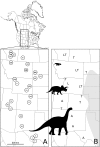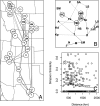Low beta diversity of Maastrichtian dinosaurs of North America - PubMed (original) (raw)
Low beta diversity of Maastrichtian dinosaurs of North America
Matthew J Vavrek et al. Proc Natl Acad Sci U S A. 2010.
Abstract
Beta diversity is an important component of large-scale patterns of biodiversity, but its explicit examination is more difficult than that of alpha diversity. Only recently have data sets large enough been presented to begin assessing global patterns of species turnover, especially in the fossil record. We present here an analysis of beta diversity of a Maastrichtian (71-65 million years old) assemblage of dinosaurs from the Western Interior of North America, a region that covers approximately 1.5 x 10(6) km(2), borders an epicontinental sea, and spans approximately 20 degrees of latitude. Previous qualitative analyses have suggested regional groupings of these dinosaurs and generally concluded that there were multiple distinct faunal regions. However, these studies did not directly account for sampling bias, which may artificially decrease similarity and increase turnover between regions. Our analysis used abundance-based data to account for sampling intensity and was unable to support any hypothesis of multiple distinct faunas; earlier hypothesized faunal delineations were likely a sampling artifact. Our results indicate a low beta diversity and support a single dinosaur community within the entire Western Interior region of latest Cretaceous North America. Homogeneous environments are a known driver of low modern beta diversities, and the warm equable climate of the late Cretaceous modulated by the epicontenental seaway is inferred to be an underlying influence on the low beta diversity of this ancient ecosystem.
Conflict of interest statement
The authors declare no conflict of interest.
Figures
Fig. 1.
Approximate locations of Maastrichtian-aged dinosaur-bearing formations from the Western Interior of North America used in this analysis. (A) Abbreviations of formation names are as follows: A, Aguja; D, Denver; Fe, Ferris; Fr, Frenchman; HM, Hell Creek Montana; HN, Hell Creek North Dakota; HS, Hell Creek South Dakota; HC, Horsehshoe Canyon; J, Javelina; Kp, Kaiparowits; Kd, Kirtland; LM, Lance Montana; LS, Lance South Dakota; LU, Lance Utah; LW, Lance Wyoming; LaC, Laramie Colorado; Law, Laramie Wyoming; M, McRae; N, North Horn; P, Pinyon Conglomerate; Sc, Scollard; SA, St. Mary's River Alberta; SM, St. Mary's River Montana; T, Tornillo Texas. (B) Locations of occurrences of the three indicator taxa, Alamosaurus (A), Leptoceratops (L), and Triceratops (T). Greyed area to the east is the approximate location of the inland seaway.
Fig. 2.
Comparison of methods of sample size correction. (A) Smoothed curves for rarefaction using Coleman's random placement method, up to n = 100. (B) Smoothed curves for Chao 1 values up to n = 100. (C) ACE values. (D) Jacknife 1 values.
Fig. 3.
Relative pairwise similarities between localities. (A) Map of the localities used in the analysis with an MST added to indicate the relative similarities between localities. The more similar two localities are to one another on the basis of the species present, the darker the line connecting them will be. Note that no clusters are formed, and many localities are more similar to far-ranging ones than neighboring localities. (B) Plot of the relative positions of an NMDS of the localities, showing no apparent clusters. (C) Pairwise dissimilarity of sites in comparison with their geographic distance from one another. As dissimilarity increases, the sites are interpreted to be less similar to one another. The line represents a locally weighted sum of squares function. The sites show a slight decay over distance, although a linear regression is not significantly different from 0. These graphs indicate low beta diversities for this assemblage. Abbreviations as defined in Fig. 1.
Similar articles
- Small theropod teeth from the Late Cretaceous of the San Juan Basin, northwestern New Mexico and their implications for understanding latest Cretaceous dinosaur evolution.
Williamson TE, Brusatte SL. Williamson TE, et al. PLoS One. 2014 Apr 7;9(4):e93190. doi: 10.1371/journal.pone.0093190. eCollection 2014. PLoS One. 2014. PMID: 24709990 Free PMC article. - Deep-time biodiversity patterns and the dinosaurian fossil record of the Late Cretaceous Western Interior, North America.
Maidment SCR, Dean CD, Mansergh RI, Butler RJ. Maidment SCR, et al. Proc Biol Sci. 2021 Jun 30;288(1953):20210692. doi: 10.1098/rspb.2021.0692. Epub 2021 Jun 23. Proc Biol Sci. 2021. PMID: 34157868 Free PMC article. - Testing co-evolutionary hypotheses over geological timescales: interactions between Mesozoic non-avian dinosaurs and cycads.
Butler RJ, Barrett PM, Kenrick P, Penn MG. Butler RJ, et al. Biol Rev Camb Philos Soc. 2009 Feb;84(1):73-89. doi: 10.1111/j.1469-185X.2008.00065.x. Epub 2008 Dec 19. Biol Rev Camb Philos Soc. 2009. PMID: 19133960 Review. - Did dinosaurs invent flowers? Dinosaur-angiosperm coevolution revisited.
Barrett PM, Willis KJ. Barrett PM, et al. Biol Rev Camb Philos Soc. 2001 Aug;76(3):411-47. doi: 10.1017/s1464793101005735. Biol Rev Camb Philos Soc. 2001. PMID: 11569792 Review.
Cited by
- Mountain building triggered late cretaceous North American megaherbivore dinosaur radiation.
Gates TA, Prieto-Márquez A, Zanno LE. Gates TA, et al. PLoS One. 2012;7(8):e42135. doi: 10.1371/journal.pone.0042135. Epub 2012 Aug 2. PLoS One. 2012. PMID: 22876302 Free PMC article. - Global ecomorphological restructuring of dominant marine reptiles prior to the Cretaceous-Palaeogene mass extinction.
MacLaren JA, Bennion RF, Bardet N, Fischer V. MacLaren JA, et al. Proc Biol Sci. 2022 May 25;289(1975):20220585. doi: 10.1098/rspb.2022.0585. Epub 2022 May 25. Proc Biol Sci. 2022. PMID: 35611532 Free PMC article. - Small theropod teeth from the Late Cretaceous of the San Juan Basin, northwestern New Mexico and their implications for understanding latest Cretaceous dinosaur evolution.
Williamson TE, Brusatte SL. Williamson TE, et al. PLoS One. 2014 Apr 7;9(4):e93190. doi: 10.1371/journal.pone.0093190. eCollection 2014. PLoS One. 2014. PMID: 24709990 Free PMC article. - Late Cretaceous restructuring of terrestrial communities facilitated the end-Cretaceous mass extinction in North America.
Mitchell JS, Roopnarine PD, Angielczyk KD. Mitchell JS, et al. Proc Natl Acad Sci U S A. 2012 Nov 13;109(46):18857-61. doi: 10.1073/pnas.1202196109. Epub 2012 Oct 29. Proc Natl Acad Sci U S A. 2012. PMID: 23112149 Free PMC article. - The spatiotemporal distribution of Mesozoic dinosaur diversity.
Mannion PD. Mannion PD. Biol Lett. 2024 Dec;20(12):20240443. doi: 10.1098/rsbl.2024.0443. Epub 2024 Dec 11. Biol Lett. 2024. PMID: 39660360 Free PMC article. Review.
References
- Whittaker RH. Evolution and measurement of species diversity. Taxon. 1972;21:213–251.
- Whittaker R. In: Evolutionary Biology. Hecht M, Steere W, Wallace B, editors. Vol. 10. New York: Plenum Press; 1977. pp. 250–268.
- Harrison S, Ross SJ, Lawton JH. Beta diversity on geographic gradients in Britain. J Anim Ecol. 1992;61:151–158.
- Condit R, et al. Beta-diversity in tropical forest trees. Science. 2002;295:666–669. - PubMed
- Novotny V, et al. Low beta diversity of herbivorous insects in tropical forests. Nature. 2007;448:692–695. - PubMed
Publication types
MeSH terms
LinkOut - more resources
Full Text Sources


